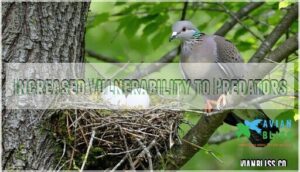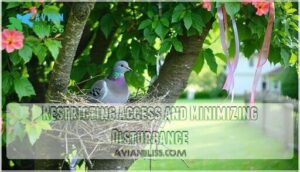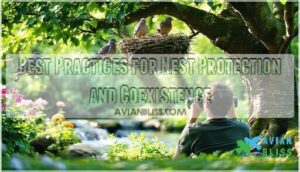This site is supported by our readers. We may earn a commission, at no cost to you, if you purchase through links.

The Migratory Bird Treaty Act protects these nests with fines up to $15,000. Even if you get permission, 80% of relocated nests get abandoned by stressed parents, and chick survival drops to just 20%.
Moving disrupts their carefully chosen location and predator-avoidance systems. Instead of relocating, create protective barriers with lightweight mesh, temporarily reroute foot traffic, or wait out the brief 12-16 day nesting period.
There are smarter ways to coexist with these feathered neighbors that keep everyone safe and legal, ensuring the well-being of both humans and birds.
Table Of Contents
- Key Takeaways
- Can You Move a Mourning Dove Nest?
- Legal Protections for Mourning Dove Nests
- Risks of Relocating Mourning Dove Nests
- Safe Alternatives to Moving Dove Nests
- Best Practices for Nest Protection and Coexistence
- Frequently Asked Questions (FAQs)
- Where do mourning doves lay eggs?
- When do Mourning Doves Nest?
- How do you get a mourning dove nest?
- Do mourning doves reuse the same nest site?
- What happens if you move a dove nest?
- When can I remove a mourning dove nest?
- How to relocate a dove’s nest with eggs?
- Do mourning doves return to the same nest?
- How do I get a permit to move a dove nest?
- Can I move a dove nest if its on my property?
- Conclusion
Key Takeaways
- You can’t legally move a mourning dove nest without federal permits – the Migratory Bird Treaty Act protects these nests with fines up to $15,000 and potential jail time.
- Moving the nest will likely kill the birds – 80% of relocated nests get abandoned by stressed parents, and chick survival drops to just 20% due to disrupted predator-avoidance systems.
- You’ve got better alternatives than relocation – create protective barriers with lightweight mesh, temporarily reroute foot traffic, or simply wait out the brief 12-16 day nesting period.
- When in doubt, consult wildlife experts – licensed professionals can assess problematic situations and navigate federal regulations while keeping you legal and the birds safe.
Can You Move a Mourning Dove Nest?
Simply put, you shouldn’t move a mourning dove nest. These delicate structures represent more than just twigs and grass—they’re protected wildlife habitats under federal law. The Migratory Bird Treaty Act makes nest removal illegal without proper permits, carrying serious penalties including hefty fines.
Don’t move mourning dove nests—they’re federally protected and relocation often kills the babies
Mourning dove parents are surprisingly sensitive creatures. Dove behavior shows they’ll often abandon relocated nests, leaving eggs and chicks vulnerable. Bird nesting cycles are finely tuned, and disruption typically spells disaster for the family.
Wildlife conservation efforts emphasize coexistence over relocation. Moving nests creates massive environmental impact through reduced breeding success. Bird safety depends on respecting their chosen locations, even when inconvenient.
Nesting safety means leaving nature’s architects alone. Instead of bird nest relocation, consider temporary barriers or modified routines. Professional wildlife rehabilitators can assess truly problematic situations and navigate Migratory Bird Treaty Act requirements when necessary. Your patience protects these gentle birds. Understanding bird nest laws is vital for their conservation and well-being.
Legal Protections for Mourning Dove Nests
Before you consider relocating that mourning dove nest on your property, you need to understand the serious legal protections these birds have under federal law.
The Migratory Bird Treaty Act makes moving an active nest without proper permits a federal offense that can result in hefty fines and even jail time.
Migratory Bird Treaty Act Overview
The Migratory Bird Treaty Act serves as your primary legal roadblock when considering nest relocation.
This century-old Federal Law makes it illegal to disturb mourning dove nests containing eggs or chicks without proper permits.
Wildlife Policy treats these birds as federally protected species, meaning:
- Bird Conservation laws override property rights
- Environmental Regulations carry serious penalties
- Nest disturbance violates Wildlife Conservation Laws
- Bird Nesting Safety requires federal oversight
- Nest Protection Measures mandate professional intervention
The Migratory Bird Treaty Act is based on federal treaty power that regulates wildlife management.
State and Local Wildlife Regulations
Beyond federal law, state-level wildlife protection laws create additional regulatory compliance requirements you can’t ignore.
Over 40 states mirror federal protections with wildlife fines ranging from $500 to $5,000 per offense.
Local ordinances add another layer—some municipalities require advance notification before nest disturbance on private property.
Wildlife conservation laws vary by location, making enforcement actions unpredictable without proper research.
Understanding wildlife conservation efforts is essential for protecting mourning dove nests and ensuring compliance with regulations.
Permit Requirements and Exceptions
Despite federal law protections for mourning doves under wildlife protection laws, obtaining permits for moving bird nests remains extremely challenging.
The permit process through U.S. Fish & Wildlife Service requires extensive documentation proving safety risks. Exception rules rarely favor private individuals, with exemption criteria focusing on public safety threats.
Fine structures include penalties up to $15,000 plus imprisonment. License fees pale compared to potential violations when relocating nesting bird species without proper authorization.
Property owners must consider bird nest removal regulations to avoid legal issues.
Risks of Relocating Mourning Dove Nests
Moving a mourning dove nest puts the entire family at serious risk, and the consequences can be heartbreaking.
When you relocate these delicate structures, you’re basically signing a death warrant for up to 80% of the eggs and chicks inside, which is a truly devastating outcome due to the delicate nature of these nests.
Nest Abandonment by Parent Birds
When you move a mourning dove nest, you’re basically pulling the rug out from under devoted bird parents.
Relocating a dove nest is like evicting a family mid-move—devastating and unnecessary
Adult mourning doves experience severe bird stress when their nest stability is disrupted, leading to nest failure in roughly 80% of cases.
These nesting bird species rely heavily on familiar surroundings for effective parental care, and moving bird nests breaks this critical bond, causing bird parents to abandon their duties entirely.
Ultimately, compromising fledgling survival is a significant risk, and understanding wildlife conservation efforts is vital in addressing the risks of relocating mourning dove nests, which can lead to nest failure and impact parental care.
Egg and Chick Mortality Rates
Even under normal circumstances, mourning dove eggs and chicks face devastating odds.
Nest failure rates soar when you move a bird nest during nesting season, with nearly 80% of relocated eggs and nestlings dying from stress and exposure.
- Chick survival drops to just 20% after relocation – imagine tiny lives depending on you making the right choice
- Egg viability plummets as parent birds abandon moved nests, leaving developing babies to face mortality factors alone
- Fledgling success becomes nearly impossible when Wild Ringneck Dove eggs lose their carefully chosen microenvironment
Even under normal circumstances, mourning dove eggs and chicks face devastating odds.
Nest failure rates soar when you move a bird nest during nesting season, with nearly 80% of relocated eggs and nestlings dying from stress and exposure.
- Chick survival drops to just 20% after relocation – imagine tiny lives depending on you making the right choice
- Egg viability plummets as parent birds abandon moved nests, leaving developing babies to face mortality factors alone
- Fledgling success becomes nearly impossible when Wild Ringneck Dove eggs lose their carefully chosen microenvironment
Increased Vulnerability to Predators
When you relocate a bird nest, you basically strip away nature’s carefully crafted predator avoidance systems.
Wild ringneck dove eggs and chicks lose their nest camouflage advantages in unfamiliar surroundings.
Parent birds can’t establish effective hawk deterrents or fledgling safety protocols in new locations.
During nesting season, established territories offer natural egg protection through familiar escape routes and defensive positioning that disappears with relocation, affecting the overall nesting season.
Safe Alternatives to Moving Dove Nests
Instead of risking the devastating consequences of relocating a nest, you have several effective alternatives that protect both the birds and comply with federal wildlife laws.
These methods allow mourning doves to complete their nesting cycle safely while addressing your concerns about the nest’s location.
Creating Protective Barriers
Instead of relocating a bird nest, you can create simple protective barriers that safeguard both the nesting site and your daily activities.
These solutions work better than moving wild ringneck dove eggs:
- Barrier Materials – Use lightweight mesh or cloth around the nesting box area
- Site Fencing – Install temporary barriers to redirect foot traffic
- Visual Deterrents – Place colorful tape near (not on) the nest location
- Protective Nets – Cover vulnerable spots with loose netting for egg safety tips
When considering nest protection, using bird netting systems can be an effective method to safeguard the nest.
Restricting Access and Minimizing Disturbance
Beyond barriers, you can limit human and pet traffic around nesting areas.
Temporarily reroute walkways and restrict outdoor activities during the 12-16 day incubation period. Keep conversations quiet and avoid sudden movements near the bird nest.
By implementing these measures, you can create a safe environment that supports bird friendly habitats.
| Access Control Method | Implementation Tips |
|---|---|
| Temporary Path Changes | Mark alternate routes with visual deterrents like ribbons |
| Noise Reduction Zones | Postpone lawn mowing and construction until fledging |
| Safe Distancing Rules | Maintain 10+ feet from nesting box locations |
Consulting Wildlife Experts
When you’re facing a tricky nest situation, professional wildlife consultation offers the safest path forward.
Licensed experts provide guidance on dove conservation while ensuring compliance with federal regulations.
They’ll assess nest monitoring needs and offer professional advice suited to your specific circumstances.
Many rehabilitators work with organizations like Cornell Lab of Ornithology to promote responsible bird watching and conservation efforts.
Utilizing wildlife expert services can be beneficial in addressing complex nest relocation issues.
Best Practices for Nest Protection and Coexistence
Once you’ve found a mourning dove nest on your property, you’ll need to adjust your routine rather than relocate the birds.
The key is creating a peaceful coexistence that protects both the dove family and your daily activities while staying within legal boundaries.
Modifying Activities Near Nests
When you discover a bird nest near your home, the first rule is simple: leave it be.
Creating a nest buffer of 15-20 feet helps protect nesting birds from disturbance.
Activity modification means postponing loud projects like mowing or construction until fledglings leave. Noise reduction during critical nesting periods supports successful bird nesting behavior and demonstrates responsible bird watching practices that promote human coexistence with wildlife.
Preventing Future Unwanted Nesting
Smart homeowners can prevent future dove drama by installing simple nest deterrents like reflective tape or spikes before breeding season starts.
Remove old, empty nests during winter months when it’s legal. Property modifications such as trimming overhanging branches and sealing ledges work wonders.
These proactive wildlife deterrence strategies protect both your property and bird conservation efforts.
Effective use of bird repellent methods can also contribute to a balanced coexistence with the birds, and support overall property protection.
When to Seek Professional Wildlife Assistance
When injured doves appear or nests threaten safety, contact licensed wildlife experts immediately.
These professionals handle bird rehabilitation legally under federal regulations, ensuring proper animal welfare and wild bird conservation.
They’ll assess whether nest rescue is necessary or if bird conservation efforts can protect the wild ringneck dove care situation safely, following federal regulations and prioritizing wild bird conservation.
Frequently Asked Questions (FAQs)
Where do mourning doves lay eggs?
Incredibly, mourning doves choose the most precarious spots.
They’ll build their flimsy platform nests on tree branches, building ledges, porch lights, or even your outdoor furniture – anywhere that’s roughly flat and offers minimal shelter.
When do Mourning Doves Nest?
Mourning doves nest from early spring through late summer, typically March through September.
You’ll see peak nesting activity during warmer months when food’s abundant and weather conditions support their delicate construction efforts.
How do you get a mourning dove nest?
Obtaining a mourning dove nest requires federal permits since they’re protected under the Migratory Bird Treaty Act.
You can’t legally collect active nests—doing so risks hefty fines and jail time.
Do mourning doves reuse the same nest site?
Picture feathered tenants returning to their favorite apartment balcony each spring.
Yes, you’ll often find mourning doves reusing the same nest sites within a season and across years, showing remarkable loyalty to successful locations.
What happens if you move a dove nest?
Moving a dove nest typically results in nest abandonment by parent birds, leading to roughly 80% mortality rates among eggs and chicks due to exposure, starvation, and predation.
When can I remove a mourning dove nest?
Like waiting for a traffic light to change, you’ll need patience until the nest empties naturally.
Remove empty nests only after young birds have fledged and parents have moved on permanently.
How to relocate a dove’s nest with eggs?
If you’re thinking about relocating a dove’s nest with eggs, you’ll need a federal permit—no shortcuts here.
Disturbing the nest risks abandonment, so call a wildlife expert first.
Sometimes, leaving well enough alone saves lives.
Do mourning doves return to the same nest?
Yes, mourning doves often return to the same nesting spots within a season, sometimes rebuilding or reusing their previous nest location.
They’re creatures of habit who’ll revisit successful sites multiple times.
How do I get a permit to move a dove nest?
Contact your state’s wildlife agency or fish and game department directly. They’ll guide you through the permit application process, which requires demonstrating genuine safety concerns or infrastructure threats before approval.
Can I move a dove nest if its on my property?
Why risk breaking federal law when you’re on your own land?
You can’t legally move mourning dove nests on your property without permits – they’re protected by federal law regardless of location.
With fines reaching $15,000 and potential jail time, it’s essential to understand the regulations surrounding protected species on your property.
Conclusion
Like a protective parent standing guard, moving a mourning dove nest isn’t just legally risky—it’s potentially deadly for the birds.
You can’t move a mourning dove nest without federal permits, and relocation typically results in nest abandonment and chick death.
Instead, work around their brief nesting period using barriers, restricted access, or expert consultation. These simple alternatives protect both you from hefty fines and guarantee these gentle birds successfully raise their young in their carefully chosen homes, ensuring a safe and successful raise.
- https://docs.google.com/forms/d/1GAQr3Kn1cURCVHUA82hAga1Wv8DCH0IuqDLRUrOpN7M/viewform?ts=63f4f653&entry.1515682415=https://www.merriam-webster.com/dictionary%2Fcan
- https://premium.britannica.com/mw-unabridged/?utm_source=mw&utm_medium=inline-def&utm_campaign=evergreen
- https://grammar.collinsdictionary.com/us/easy-learning/when-do-you-use-can-and-could-in-english
- https://tr.thefreedictionary.com/kutu
- https://es.thefreedictionary.com/esforzar











